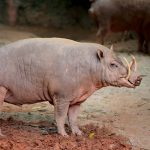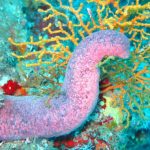While Down Syndrome is most commonly associated with humans, animals can also be affected by the condition. Also known as Trisomy 21, Down Syndrome occurs when an individual has three copies of chromosome 21 instead of the usual two. This extra chromosome results in a range of physical and intellectual impairments. In animals, the condition typically leads to skeletal abnormalities, heart defects, and a reduced life expectancy.
However, some animals with Down Syndrome are able to lead relatively normal lives. For example, a deer named Bambi that was born with the condition became a popular attraction at a wildlife park in Germany. While animals with Down Syndrome are often euthanized at birth, awareness of the condition is slowly growing, and more people are working to provide care and support for these special creatures.
There are a number of animal species that have been documented as having Down Syndrome, including dogs, cats, horses, and rabbits. In most cases, animals with Down Syndrome exhibit similar physical characteristics to those seen in human patients, such as a flattened facial profile, upward-slanting eyes, and shorter than average limbs. They may also have mild to moderate intellectual disabilities. While there is no cure for Down Syndrome, animals with the condition can often lead happy and healthy lives with the proper care and support.
We have compiled a small list of some animals that can be affected by Down Syndrome or similar:
Kenny White Tiger
- Scientific Name: Panthera tigris
- Type of Animal: Mammals
- Diet: Carnivores

Kenny was born on April 4, 1998, and died on June 28, 2008, as a result of cancer. Scientists are baffled as to how he acquired downs syndrome, but they suspect it was caused by inbreeding in his family. Kenny died when he was 10 years old, and Willie died when he was twelve years old.
White tigers are cross-eyed because the white coat gene causes the optic nerve to be connected to the incorrect side of the brain. This is true even though the white tigers appear to have normal eyes. Clubfoot, cleft palates, spinal deformities, and organ anomalies are all common in this group of people. Kenny’s malformations are the product of decades of inbreeding, not the type of chromosomal abnormality that causes Down syndrome in people.
Apes
- Scientific Name: Hominoidea
- Type of Animal: Primates
- Diet: Omnivorous
Apes appear to have a genetic defect at least somewhat similar to Down syndrome on occasion, despite the fact that the presence of animals with Down syndrome has been debunked. There are 24 chromosomal pairs in apes, although humans only have 23 pairs, and it has been discovered that certain apes have an extra copy of chromosome 22, which is similar in size to human chromosome 21.
Kitten Otto
- Scientific Name: Felis catus
- Type of Animal: Mammals
- Diet: Carnivores
Cats such as Kenny are not the only ones who have been mistakenly identified as having Down syndrome. Otto the kitty has become something of an internet sensation in his home country of Turkey. Internet commentators suggested that the effects of Down syndrome caused the young kitten’s early death, which occurred in 2014 at the age of just over two months.
Chimpanzee
- Scientific Name: Pan troglodytes
- Type of Animal: Mammals
- Diet: Omnivores
It was discovered that chimpanzees with an extra chromosome 22 exhibited growth impairments, cardiac difficulties, and other symptoms “like in human Down syndrome.” Despite this, the researchers only stated that the chimp’s condition was “analogous” to Down syndrome, not that it was actually Down syndrome. Furthermore, this is only the second instance of this chromosomal abnormality in a chimp, and scientists are still learning a great deal about the phenomenon.
Monty Cat
- Scientific Name: Felis catus
- Type of Animal: Mammals
- Diet: Carnivores

Monty, another well-known cat that has been rumored to have Down syndrome, is another example of a cat with Down syndrome. In accordance with his official website, Monty came into the world from an animal shelter when he was just three years old. He is affected by an abnormality in the chromosomes that results in a sunken nasal bridge.
Mice
- Scientific Name: Mus musculus
- Type of Animal: Mammals
- Diet: Herbivores
According to the findings of researchers, mice can have chromosomal abnormalities. It is possible that they will grow an additional chromosome 16, which would result in Down syndrome-like traits. However, due to the fact that babies with this defect frequently die before they are born, it is almost never detected in naturally occurring mouse populations in nature. Researchers are only aware of the possibility because they genetically designed the conditions in which they could investigate it in laboratory mice.
The Cat, Lil Bub

Among her genetic defects were extra toes and feline dwarfism, both of which made it difficult for her to maintain her tongue in her mouth when she was eating or drinking.
Giraffes
- Scientific Name: Giraffa camelopardalis
- Type of Animal: Mammals
- Diet: Herbivores

Image Source: Youtube Screenshot
While the giraffe is well-known for possessing the longest legs of any mammal, witnessing a small giraffe may come as a surprise, but it does happen. Down syndrome, on the other hand, does not affect these animals, in any way. A genetic disorder results in unevenly formed bones in the spine as well as arms and legs. It can also occur in the hands and feet.
Another problem that can occur in giraffes is birth hypoxia, which occurs when the child is deprived of oxygen and does not grow correctly after delivery. In the case of Julius the giraffe, who was born at the Maryland Zoo with a head that was tilted to the right as the result of a damaged brain and a tongue that was handicapped as a result of nerve damage, the zoo was able to save the animal’s life.
Dogs
- Scientific Name: Canis lupus familiaris
- Type of Animal: Mammals
- Diet: Omnivorous
A large tongue is a common symptom of Down syndrome, as well as a symptom of macroglossia, which may occur in both humans and canines. When dogs’ tongues develop abnormally huge and droop out of their mouths as a result of bigger cells or muscular tension, they are said to have macroglossia, a condition known as dangling tongues.
Their tongues have the potential to create respiratory difficulties and restrict their range of motion. Despite the fact that it is common to assume that a dog with macroglossia has Down syndrome, the condition is usually caused by something else. An allergic reaction or exposure to illnesses such as hypothyroidism are examples of adverse reactions to medications.
Monkey
- Scientific Name: Simiiformes catarrhini
- Type of Animal: Mammals
- Diet: Omnivores
It has been revealed that the world’s first example of a monkey with Down’s syndrome has been identified. The genetic defect was discovered by the monkey’s behavior, which was then confirmed through chromosomal research. A monkey with Down’s syndrome has previously been detected in chimps and gorillas, but never before in a monkey with the condition. The signs of the monkey’s disease are identical to those of individuals with the disorder, both in terms of behavior and genetic makeup.
Are There Videos of Sharks Pooping?
Yes, there are videos of sharks’ poop explained in video. These informative videos delve into the intriguing world of shark digestion, shedding light on their excretory process. Though unusual, witnessing such natural behaviors can provide valuable insights into the lives of these apex predators and the ecosystems they inhabit.
Are Octopuses Carnivores or Omnivores?
Are octopuses carnivores or omnivores? The octopus diet: carnivores or omnivores?? Octopuses are carnivores, feeding mainly on other marine animals like crustaceans, small fish, and mollusks. Their sharp beaks rip through their prey’s flesh, while their strong arms and suckers secure their meal. Although they may scavenge on occasion, their primary diet consists of meat.
Koala
- Scientific Name: Phascolarctos cinereus
- Type of Animal: Mammals
- Diet: Herbivores
This newborn koala with Down syndrome is the prettiest thing you’ve ever seen. When you look at his tiny little paws, you can scarcely tell that he’s chomping on a leaf!!
All of us have genetic variances, and these variations have an influence the way we live in the Arctic. This polar bear with Down syndrome is the prettiest thing you’ve ever seen! His eyes are tired, yet they are also loving at the same moment.
Conclusion
This is because Down syndrome is a human-specific condition. In certain situations, as we learned in this article, animals can have a condition that is similar to Down syndrome in people, and this is something that we should be aware of.









